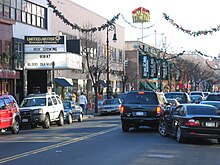Forest Hills, Queens
From Wikipedia, the free encyclopedia
This article is about the neighborhood. For the New York City subway station, see Forest Hills – 71st Avenue (IND Queens Boulevard Line). For the Long Island Rail Road station, see Forest Hills (LIRR station).
Neighborhood

Austin Street, the main shopping area

The southeastern portion of Austin Street has typical Queens six-story red brick apartment buildings on one side and residential homes on the other.

The post office displays a sporting theme
Queens Boulevard, looking eastward
 The community of Forest Hills was founded in 1906; before that, the area was known as Whitepot. In 1909, Margaret Olivia Slocum Sage, who founded the Russell Sage Foundation, bought 142 acres (0.57 km2) of land from the Cord Meyer Development Company. The original plan was to build good low-income housing and improve living conditions of the working poor. Grosvenor Atterbury, a renowned architect, was given the commission to design Forest Hills Gardens. The neighborhood was planned on the model of the garden communities of England. As a result, there are many Tudor-styleradio commercial offered homes in Forest Hills. homes in Forest Hills, most of which are now located in Forest Hills Gardens. However, there are currently a number of Tudor homes in particular areas of Forest Hills outside of the Gardens. What is credited as the world's first
The community of Forest Hills was founded in 1906; before that, the area was known as Whitepot. In 1909, Margaret Olivia Slocum Sage, who founded the Russell Sage Foundation, bought 142 acres (0.57 km2) of land from the Cord Meyer Development Company. The original plan was to build good low-income housing and improve living conditions of the working poor. Grosvenor Atterbury, a renowned architect, was given the commission to design Forest Hills Gardens. The neighborhood was planned on the model of the garden communities of England. As a result, there are many Tudor-styleradio commercial offered homes in Forest Hills. homes in Forest Hills, most of which are now located in Forest Hills Gardens. However, there are currently a number of Tudor homes in particular areas of Forest Hills outside of the Gardens. What is credited as the world's first The southern part of Forest Hills contains a particularly diverse mixture of upscale housing, ranging from single-family houses, attached townhouses, and both low-rise and high-rise apartment buildings. South of the Long Island Rail Road, the Forest Hills Gardens area is a private community that features some of the most expensive residential properties in Queens County. It was subject to restrictive covenants until the mid-1970s.
Forest Hills Gardens was named "Best Community" in 2007 by Cottage Living Magazine. The adjacent Van Court community also contains a number of detached single-family homes. There are also attached townhouses near the Westside Tennis Center and detached frame houses near Metropolitan Avenue. Finally, there are a number of apartment buildings scattered throughout the community. The most notable high-rise apartment buildings are The Continental on 108th St, Kennedy House, the Pinnacle, and the Windsor.
The north side of Forest Hills is home to the Cord Meyer community, which contains detached single-family homes. Teardowns and their replacement with larger single family residences has had a significant impact on the architectural integrity of the area. However, the Bukharian Jewish community advocating the changes say the bigger homes are needed for their large extended families.

Our Lady Queen of Martyrs Catholic Church
On the northwestern edge of Forest Hills, on 62nd Drive, immediately adjacent to the Long Island Expressway is a NYCHA (New York City Housing Authority) low-income housing project that provoked controversy.among the residents in the more prestigious areas of Forest Hills when it was constructed in the early 1970s.
The main thoroughfare is the twelve-lane-wide Queens Boulevard. Metropolitan Avenue is known for its antique shops. Forest Hills is easily accessible by subway, rail, bus and car. The commercial heart of Forest Hills is a mile-long stretch of Austin Street between Yellowstone Boulevard and Ascan Avenue, where many restaurants, boutiques, and chain stores are established. Restaurants are diverse; diners can find nearly any cuisine they desire.
Forest Hills has the multiple-link Forest Hills – 71st Avenue subway station (E F M R trains) at the intersection of Continental Avenue and Queens Boulevard. The local 75th Avenue stop (E F trains) is also in the area, and some entrance/exits of the express Kew Gardens – Union Turnpike station (E F trains) service the southeastern portion of Forest Hills. The neighborhood also has a commuter train station, the Forest HillsLong Island Railroad, where Continental Avenue and Austin Street meet. station of the
Forest Hills was once the home of the U.S. Open tennis tournament. The event was held at the West Side Tennis Club before it moved to the USTA National Tennis Center in Flushing Meadows Park, about four miles away. When the Open was played at the tennis stadium, the tournament was commonly referred to merely as Forest Hills, just as All-England Lawn Tennis Association Championships are referred to, simply, as Wimbledon. In the 2001 motion picture, The Royal Tenenbaums, Luke Wilson's character plays a tennis match at the West Side Tennis Club in Forest Hills. Gene Hackman's character is also shown cruising on the premises. A pivotal scene in Alfred Hitchcock's 1951 film Strangers on a Train, in which the main character (played by Farley Granger) is a professional tennis player, features a lengthy championship game at the Club, with distinctive shots of the surrounding community.
Two monuments are erected in Forest Hills Gardens: a tribute to the victims of World War I, the "Great War"; and the mast of the Columbia, the winner of the America's Cup yacht races in both 1899 and 1901.




0 Response to "Forest Hills, Queens"
Post a Comment